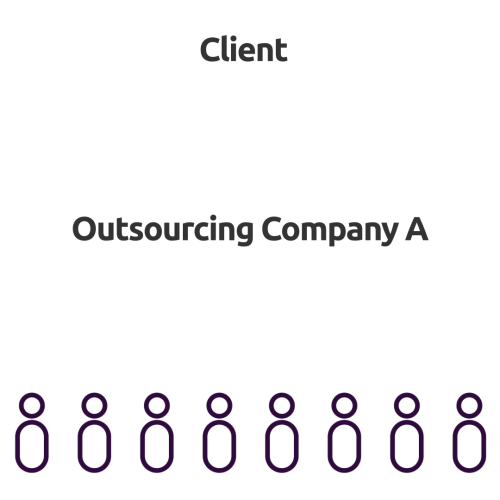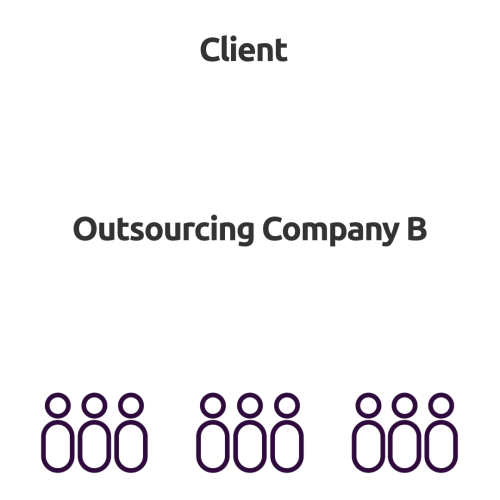First off, what is outsourcing?
Outsourcing is utilizing another business’ strengths to get a specific task off your shoulders. For example, if punching in thousands of cells into a spreadsheet is keeping your employees from performing better, you could pay another business to accomplish that data entry. The principle is simple but it can be nerve-wracking. You’ve worked hard to build your business and will passing off a part of your business’ work diminish quality? delay turnaround time? Or worse? Is outsourcing even a good idea?
Believe me, there’s plenty of mistakes we’ve witnessed over our 20 years helping stateside firms get the best results from their outsourced efforts. To help with that, here is what we feel are the 5 fatal mistakes of outsourcing.


Not having an On-Shore Partner
Remove the frustrations from not knowing where to turn for answers
In a study by Virgin, they come to a simple conclusion: better business is done in person. From the quality and amount of ideas generated to better decision making, 95% of those in the study say that face to face meetings are essential to long term relationships.
If an issue pops up, who do you contact? How long does it take to hear back? It’s imperative that the business you trust is able to meet with you locally and address your needs in person.
Working with a US-based firm directly, aids both in productivity and accountability. In our case study of a leading fintech company, our partner saw a 1,620% growth in their number of clients over 40 months. Not only did they have a great team and product, but by having a stateside partner, together we were able to create processes for productivity that streamlined workflow and maximized their results.
Instead of spending your time worrying if what you need to be done gets done, a stateside partner gives you the assurance and responsiveness that, should an issue arise, it can be addressed, same day.


Project minded rather than Relationship minded
Create an extension of your existing staff
89% of companies that outsource continue to do so with their current provider. Why? Because they know that working with a company that knows your methods is more important than finishing a single task.
It takes a lot of effort to do one-off projects. These projects require learning new processes, new resources, and new tools; every time. By entering a relationship-minded engagement, you enable your outsourcing partner to learn your processes and expectations and deliver solutions that are both repeatable, and scalable.
Outsourcing takes time. It takes time for your stateside team to document processes for the work to be done correctly. It also takes time for your outsourcing partner to learn these procedures and implement them. This time can either be a one-time investment in an improved product and happier employees or a continuous expense. Because over time, each step in your process becomes refined.
You no longer have to constantly train a new team and then fail because work was done poorly, late, etc. Once your overseas team learns the process, the next steps get simpler, faster and cheaper.


Not having a dedicated team
Create clarity with a team focused on your mission, vision, and goal
Imagine using a temp agency to fill critical roles in your service pipeline. Each time a new temporary employee came on-board, you would need to train them on the tasks they would perform, only to have them leave and take those skills elsewhere.
Branching off that last mistake, the best outsourcing results come from having a dedicated team. Usually, when you do project-based engagements, you don’t get a dedicated team. Think of it this way.
Outsourcing Model A

Outsourcing Model B



Hourly billing
Add certainty to your budget
Outsourcing is already uncertain enough. If you add a fluctuating cost on top of it, managing your project could cause anxiety. Hourly billing can be catastrophic to your outsourcing efforts because you can’t budget that way. This uncertainty and lack of clarity can negatively impact your planning and your project’s success.
A flat-rate billing engagement means you don’t have to worry about expending energy on managing hours or auditing time logs. You can be focused on the end goal of delivering your solution to your client with peace of mind about your bottom line.


Rushing to the Finish Line
Remove the headache of having to redo work
Lastly, the most important mistake made in outsourcing is not working with a firm that is service-focused. This may sound vague but let me explain.
The number one complaint about outsourcing companies is that the staff is unqualified or that they provide poor quality of service. And while the industry has seen this number drop by 8% over the last two years, it still accounts for 20% of complaints companies have with their outsourcing company. Why is this the case?
Project-based outsourcing firms aim to churn out as many projects as possible in as little time as possible. Because project-based firms aren’t expecting work beyond that one project, their resources are oriented to project turnover and not long-term service after delivery. This results in lower quality and in the worst cases, needing to redo work that you paid to have done by stateside employees that would have cost more to do to it in the first place.
While this type of service may be more cost-effective up front, you get what you pay for. Partner organizations look to add value by providing maintenance and support to the relationship because they are incentivized to improve.
Action Steps
Define – Look for a firm that comes alongside you and understands your business needs. The best outsourcing partners will define the processes and tasks you are looking to find talent for those specific needs.
Design – Design the outsourcing relationship so your overseas team and on-shore team can integrate and work well together. This includes establishing the communication channels and tools to manage the work and tasks you are outsourcing. We recommend Slack, Github, Trello, and Zendesk.
Deliver – Work with your outsourcing partner to onboard your new team into your workflow and help you start your relationship successfully. This will help you work through communication issues that may arise and make expectations clear.

Other Articles You Might Be Interested In:

How to Manage Your Outsourced Accounting Team
With businesses moving to a remote environment, there is a common question about how you manage an outsourced accounting team. How do you make sure their work aligns with your objectives? How do you form a healthy work-relationship with remote accountants? How do you...
read more
5 Business Tasks You Could be Outsourcing
Too many business owners think they don't need help with their tasks. They think that getting more hands involved means way more expenses for the company. Little do they know, outsourcing could actually help their business grow. (And save them money!) Repetitive or...
read more